Workhouse Clothing
On admission to a union workhouse, inmates were bathed and issued with an outfit of clothing for the duration of their stay, their own clothing being put into store until their departure. The outfit typically included under and outer wear, with two of any items such as shirts and stockings that would need regular laundering. Each item would be marked with the outfit's identification number and also to identify it as workhouse property and so discourage theft.
The provision of workhouse clothing (the term 'uniform' was never officially used) served a number of practical purposes. It prevented any infestation, such as fleas, that the inmate might be carrying from being carried into the workhouse. It ensured that the inmate was suitably attired for work or whatever else was appropriate for their situation. Their own clothing could be returned to them on leaving, in the same condition (apart from possibly having been disinfected) as when they arrived.
Despite what is sometimes said, the clothing was not intended to be degrading or dehumanising. It did, however, provided a simple control mechanism over inmates' movements: leaving the workhouse in uniform without permission would constitute theft of union property and could lead to an appearance before the magistrates and a possible sentence of prison with hard labour.
The Poor Law Commissioners anticipated that union workhouse inmates would make their own clothes and shoes, providing a useful work task and a cost saving. However, they probably failed to realise the level of skill required to perform this and uniforms were more usually bought-in. The inmates' clothing, particularly the men's, was usually made from fairly coarse materials with the emphasis being on hard-wearing rather than on comfort and fitting. Regardless of whether the clothing was made in the workhouse or bought in in bulk, there was inevitably however, a certain degree of uniformity in its appearance. The Poor Law Commissioners decreed that the clothing was to be made out of 'such materials as the Board of Guardians may determine' and 'need not be uniform either in colour or materials.'
In 1837, the Guardians of Hereford union advertised for the supply of inmates' clothing. For the men this consisted of jackets of strong 'Fernought' cloth, breeches or trousers, striped cotton shirts, cloth cap and shoes. For women and girls, there were strong 'grogram' gowns, calico shifts, petticoats of Linsey-Woolsey material, Gingham dresses, day caps, worsted stockings and woven slippers. ('Fernought' or 'Fearnought' was a stout woollen cloth, mainly used on ships as outside clothing for bad weather. Linsey-Woolsey was a fabric with a linen, or sometimes cotton, warp and a wool weft — its name linked by some to the village of Lindsey in Suffolk, or simply derived from "Lin" (an old name for flax) and "wool". Grogram was a coarse fabric of silk, or of mohair and wool, or of a mixture of all these, often stiffened with gum.)
Male inmates were usually kitted out in jacket, trousers, waistcoat and some kind of hat, such as a flat cap or a Breton cap. The bowler-style billycock hat was adopted in some unions, both in the north such as Doncaster in Yorkshire, and in the south such as Tonbridge in Kent.
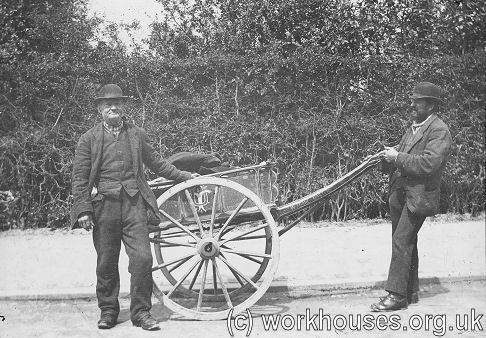
Male inmates of Tonbridge workhouse, c. 1897.
© Peter Higginbotham.
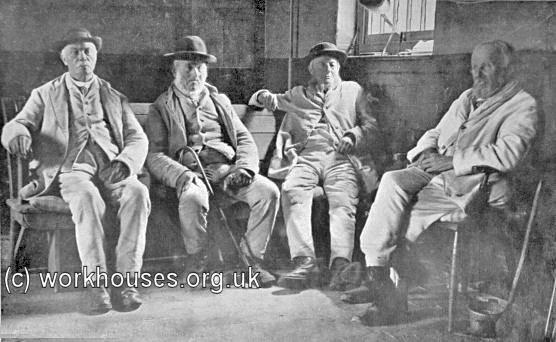
Male inmates, c.1911.
© Peter Higginbotham.
In later years, the clothing for able-bodied women was generally a shapeless, waistless shift, often in blue-and-white-striped cotton material, reaching to the ankles, perhaps with a smock over.
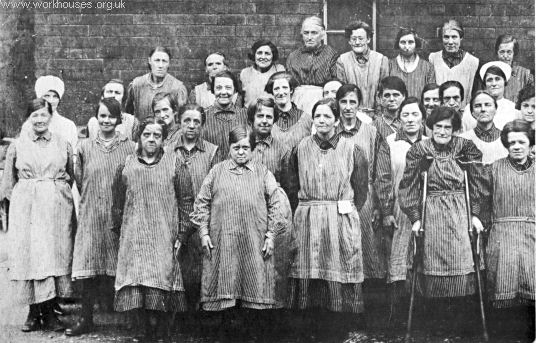
Able-bodied female inmates' clothing, 1920s.
© St James Hospital, Leeds.
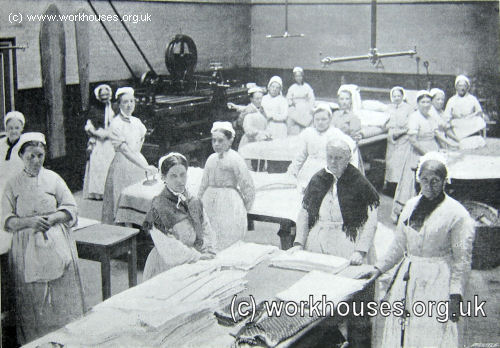
Holborn Mitcham workhouse laundry, 1896.
© Peter Higginbotham.
The typical clothing for older women was a long gown, apron, shawl and bonnet or mop-cap.
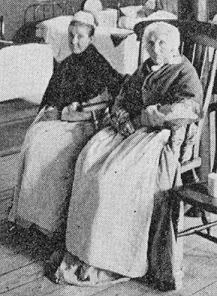
Old women inmates' clothing, c.1902.
© Peter Higginbotham.
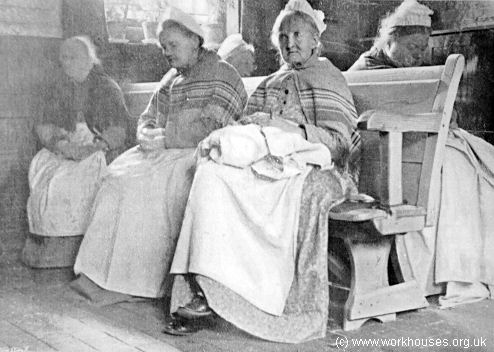
Old women inmates' uniforms, c.1911.
© Peter Higginbotham.
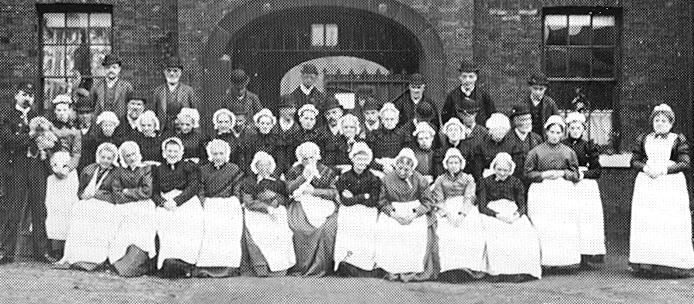
Doncaster Hexthorpe Lane inmates, 1890s.
Reproduced by kind permission of Doncaster Library and Information Services.
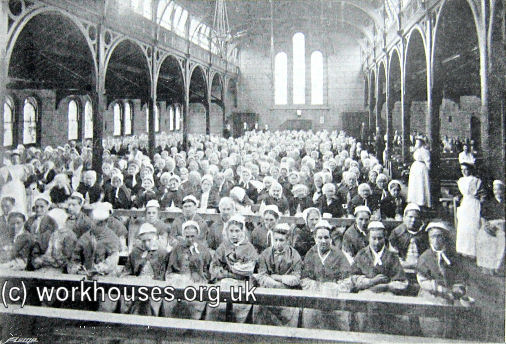
Holborn Mitcham workhouse old women dining, 1896.
© Peter Higginbotham.
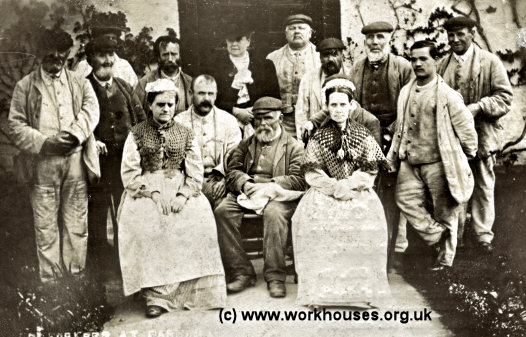
Barham inmates, early 1900s.
© Peter Higginbotham.
The daughter of the matron of Ongar workhouse in the early 1900s recalls that:
In some workhouses, the custom was practiced of marking out certain categories of inmate by clothing of a particular style or colour. At Bristol, in the 1830s, for example, prostitutes wore a yellow dress, and unmarried pregnant women a red one. In 1839, the Poor Law Commissioners issued a minute entitled "Ignominious Dress for Unchaste Women in Workhouses" in which they deprecated these practices. However, more subtle forms of such identification often continued. At the Mitford and Launditch workhouse at Gressenhall, unmarried mothers were made to wear a 'jacket' of the same material used for other workhouse clothing. This practice, which resulted in their being referred to as 'jacket women', continued until 1866.
Despite the general drabness of workhouse clothing, there was the occasional exception such as this woman's scarf from the Toxteth workhouse.
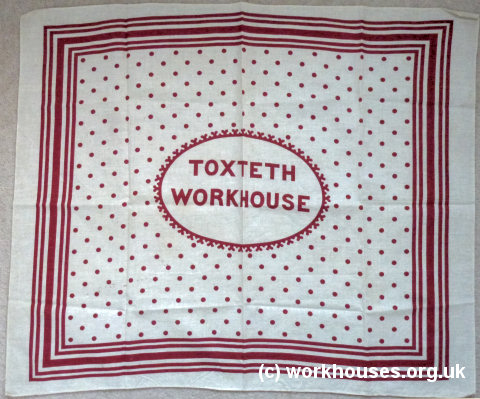
Toxteth workhouse inmates' scarf, date unknown
© Peter Higginbotham.
Workhouse nurses and cooks wore conventional attire of the period for those occupations - starched aprons and hats etc.
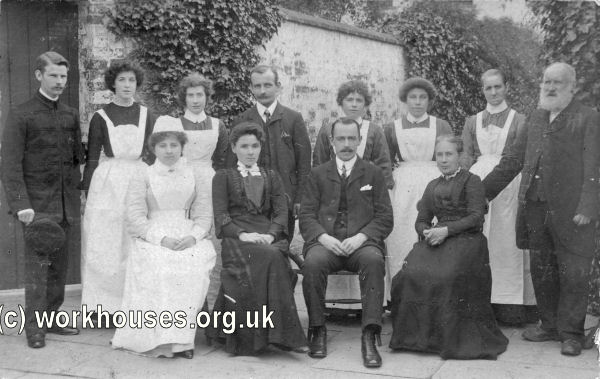
Mr and Mrs Solomon and workhouse staff, 1905.
© Peter Higginbotham.
The workhouse porter often wore a formal uniform with braid or piping.
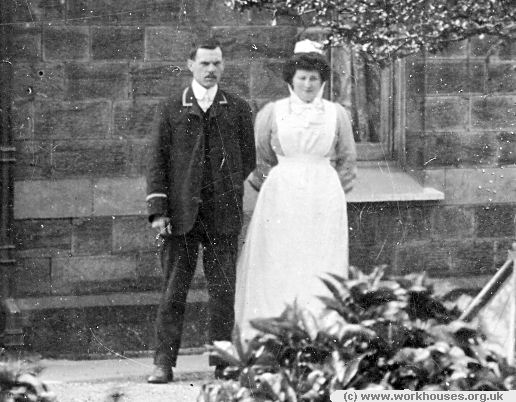
Burnley workhouse porter and nurse, c.1906.
© Peter Higginbotham.
Unless otherwise indicated, this page () is copyright Peter Higginbotham. Contents may not be reproduced without permission.



